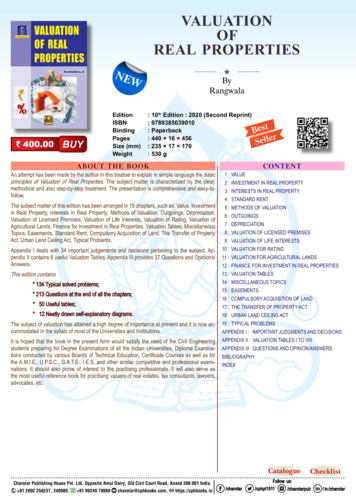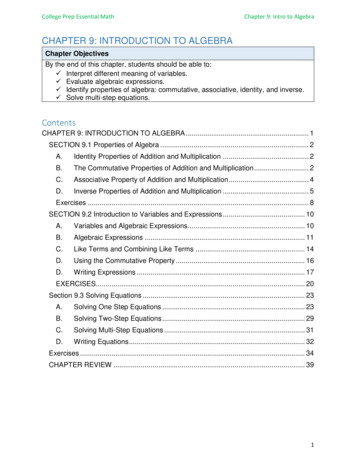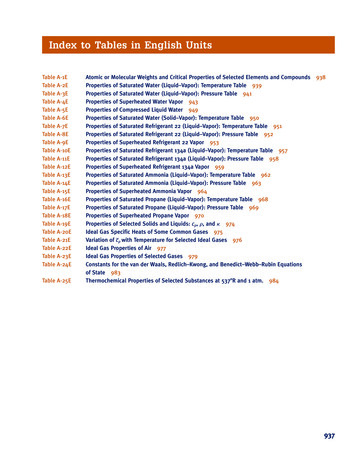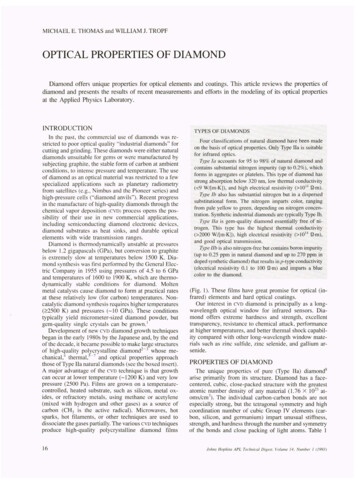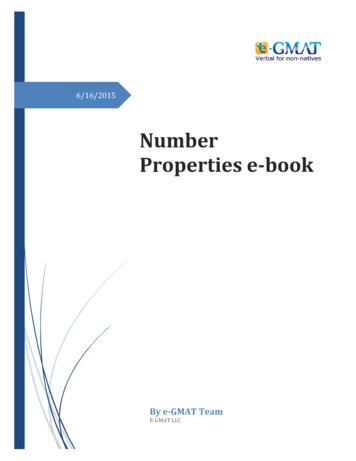
Transcription
6/16/2015NumberProperties e-bookBy e-GMAT TeamE-GMAT LLC
e-GMAT LLC. Unauthorized copying for commercial and competitive purposes is not allowed.ContentsDo you make these 3 mistakes in GMAT Even-Odd Questions? . 3Getting intimidated by complex expressions . 4What we mean . 4What can you do to avoid this pitfall? . 4Takeaway . 6Test Yourself . 7Wasting time on unimportant terms . 7What we mean . 7What can you do to avoid this pitfall? . 7Takeaway . 8Test Yourself . 9Getting stumped in division . 9What we mean . 9What can you do to avoid this pitfall? . 10Takeaway . 11Test Yourself . 11Conclusion. 12Practice Questions. 13Question 1 . 13Question 2 . 13Question 3 . 133 deadly mistakes you must avoid in LCM-GCD Questions . 14Getting confused by different names of LCM-GCD . 15Different way to express GCD. 15Different ways to express LCM . 16Takeaway . 17Not having prime factorization as the default approach . 17Takeaway . 19Being unmindful of constraints on LCM-GCD . 19Range of GCD . 19Range of LCM. 20Takeaway . 22
e-GMAT LLC. Unauthorized copying for commercial and competitive purposes is not allowed.Conclusion. 23
e-GMAT LLC. Unauthorized copying for commercial and competitive purposes is not allowed.Do you make these 3 mistakes in GMATEven-Odd Questions?Even-Odd numbers is deemed to be among the easier concepts on the GMAT Quant, and yet, come700 level questions from this concept, many students get them wrong. We have seen closely studiedthe mistakes that students make in Even-Odd questions – from the doubts they ask in Even-Oddquestions in our internal forums, from the mistakes made by 1000 students in our recurringNumber Properties Live Classroom, and most recently, in The E-GMAT Number PropertiesKnockout that was attempted more than 5000 times.What we have observed is that there are three primary pitfalls that students fall into in Even-Oddquestions:1. Getting intimidated by complex expressions2. Wasting time on unimportant terms3. Getting stumped in divisionIn this article, we will explain each pitfall with examples, discuss why it is important to avoid thatpitfall, tell you how to avoid it and finally, give you 700 level practice questions.Sounds good? So read on, to make sure that you’ll never be among the unlucky students who err inEven-Odd questions. Amen to that!
e-GMAT LLC. Unauthorized copying for commercial and competitive purposes is not allowed.Getting intimidated by complex expressionsWhat we meanA few Even-Odd questions may have scary-looking expressions. For example, consider this questionP1.1 If j is a positive integer, is (j3-27)2(j3 1)3 odd?Did you feel a bit nervous reading this question? Well, that is the first pitfall that you have to guardagainst. Because, if you let yourself become nervous, you will:i)ii)Either leave the question without answeringOr you will panic; panic clouds our ability to think rationally and so, increases our chancesof making an error. For example, in your panic, you may scramble to remember and apply the formula fora3 b3 on the terms of this expression, and then, realize, much to your dismay, thatyou’ve complicated the question even further So, as you can see, ‘getting intimidated by complex expressions’ is indeed a dangerous pitfall.What can you do to avoid this pitfall?The next time you face such a question and notice your heartbeat increasing, take a deep breath andtell yourself,“Since this is a GMAT question, it can be simplified elegantly.”This is true! The beauty of official GMAT questions is that no matter how complex they look, they canalways be simplified to a couple of cases.
e-GMAT LLC. Unauthorized copying for commercial and competitive purposes is not allowed.ExampleSo, let’s think through the question we posed above and see how it can be simplified.1st SimplificationThe given expression is (j3-27)2(j3 1)3You’re probably familiar with the property that the power of a number doesn’timpact the even-odd nature of the number. (Even)n, where n is a positive integer Even Similarly, (Odd)n OddSo,i)(j3 – 27)2 will have the same even-odd nature as (j3 – 27). Similarly, (j3 1)3 will have thesame even-odd nature as (j3 1)ii)j3 will have the same even-odd nature as j itself.So, using this property, we’ve done the first level of simplification: now, we only have to determine theeven-odd nature of this, simpler expression: (j-27)(j 1)2nd SimplificationThe simpler expression is a product of 2 terms: (j – 27) and (j 1)
e-GMAT LLC. Unauthorized copying for commercial and competitive purposes is not allowed.When will the product of 2 terms be odd? Only if each of the 2 terms are themselves odd. If even one ofthese terms is even, the product will be even.So, to answer the question, we need to know: are each of the 2 terms odd?So, from the earlier situation of dealing with the product as a whole, we are now dealing with individualterms only: (j – 27) and (j 1)Getting to the answerNow, j can either be Even or Odd.Case 1: j is oddIn this case, j 1 Odd Odd EvenAnd j - 27 Odd - Odd EvenSince both the terms are Even, the answer in this case will be NO, the given expressionin not odd.Case 2: j is evenIn this case, j 1 Even Odd OddAnd, j - 27 Even - Odd OddSince both the terms are odd, the answer in this case will be YES, the given expression isoddSo, as you can see, using this step-wise approach, we’ve been able to simplify the question to this:Is j even?TakeawayUse the properties of Even-Odd combinations to simplify scary-looking expressions. Have theconfidence that all Even-Odd questions in the GMAT can be easily simplified. Don’t get intimidatedby complex expressions in Even-Odd questions and avoid the impulse to search for algebraicformulae to apply on such expressions.
e-GMAT LLC. Unauthorized copying for commercial and competitive purposes is not allowed.Test YourselfYou’ll know that you’ve learnt this lesson well, if your heart doesn’t skip a beat at the first look ofthe following question:P1.2 If X P*NK P where N and K are positive integers, is X divisible by 2?1.2.N KN 915P35 35P is EvenThe detailed solution of this question is available hereThis is the end of mistake 1. Click here to go back to the table of contents.Wasting time on unimportant termsWhat we meanWhat we mean by ‘unimportant terms’ is ‘the terms that do not impact the Even- Odd nature of theexpression. For example, consider the following question:P2.1 If a and b are integers, is a 8b even?In this expression, the term 8b will be even, irrespective of whether b is even or odd (because,Even*Odd Even and Even*Even Even). So, you should focus all your attention on analyzingwhether a is even or odd, because that is what will get you to the answer.If you fall into the pitfall of analyzing the given information to determine the even-odd nature of b,then you’ll be squandering your most precious resource in the GMAT – Time. Minutes frittered awaythus may create a time crunch towards the end of the test, and then, coming under the pressure ofthe seconds ticking away, you may frantically answer even questions that you know, wrong. So, it isvery important to be on strict guard against even a moment spent on unneeded analysis. And, inEven-Odd questions, it’s all too easy to fall into this booby trap.What can you do to avoid this pitfall?In order to not waste even a second on the unimportant terms, here are a few pointers that youshould use to weed out the unimportant terms in an expression:i.A term of the form (Even number)*(X) will always be evenii.In a term of the form (Even number) X, the (Even number) plays no role in theEven-Odd nature of the term
e-GMAT LLC. Unauthorized copying for commercial and competitive purposes is not allowed.iii.In a term of the form (Odd number)*(X), the (Odd number) plays no role in theEven-Odd nature of the termExampleYou’ve already seen an example of the first pointer in Question P2.1Here’s an example that will show all the three pointers in action:P2.2 If a, b, c and n are integers, is a 8b (2n 1)c even?1st PointerThe term 8b will always be even, irrespective of the value of b2nd PointerIn the given expression, the even term 8b doesn’t impact the even-odd nature of this expression. So, theexpression will have the same even-odd nature as the sum a (2n 1)c3rd PointerIn the term (2n 1)c, (2n 1) is an odd number, and so plays no role in the even-odd nature of this term.So, the term (2n 1)c will have the same even-odd nature as c.So, the expression a (2n 1)c will have the same even-odd nature as the expression a cTo some students Pitfall 2 may seem similar to Pitfall 1 because the strategy suggested to avoid Pitfall2 (the Three Pointers) also leads to simplification of the given expression. However, even though theeffect of the strategies suggested in Pitfalls 1 and 2 may be the same, the problems that these strategiestackle are different. In Pitfall 1, the problem is that a student may get intimidated by a difficult-lookingexpression. In Pitfall 2, on the other hand, the problem is that a student may waste time on analysingterms that do not contribute to the Even-Odd nature of an expression. These are two distinctproblems, and so, Pitfalls 1 and 2 are distinct as well.TakeawayWhen you see an expression, first use the Three Pointers to determine the unimportant terms.Do not waste precious time on processing the unimportant terms.
e-GMAT LLC. Unauthorized copying for commercial and competitive purposes is not allowed.Test YourselfSee how much time you take on this question and if you waste time on any term that doesn’tdeserve it:P2.3 If a, b and n are positive integers such that n 3a – b3, is n2 3 divisible by 2?(1) a2 – 4b3 – 5 0(2) 3b3 – a2 6 0The detailed discussion of this question is available hereThis is the end of mistake 2. Click here to go back to the table of contents.Getting stumped in divisionWhat we meanIf A and B are given to be integers, where A B and A/B is an integer, can you smoothly work outthe relation between the even-odd nature of A, B and the integer A/B?For example, consider the following question:
e-GMAT LLC. Unauthorized copying for commercial and competitive purposes is not allowed.P3.1If A, B and X are integers, X/B is an even integer and XB/(4A 1) is an integer, isXB/(4A 1) odd?If you don’t have a firm approach to deal with this and similar questions, you’re bound to feelflummoxed, and then you’ll:i)ii)Either give up this question as too difficultOr will gingerly try number substitution to see which values of X and B give an evenvalue of X/B, and then with those values of X, try to see if XB/(4A 1) is odd. Thisapproach is time-consuming and error-prone, because you may miss out on somepossible cases.Both possible actions are costly – in terms of lost score points and lost time. So, it is important tonot fall prey to such questions.What can you do to avoid this pitfall?This pitfall is easily avoided by following the standard approach presented here –Convert the division equation into a multiplication equation.ExampleLet’s illustrate this approach on question P3.1The division equation that we can write for the terms X/B is:𝑋 𝐸𝑣𝑒𝑛 𝑛𝑢𝑚𝑏𝑒𝑟𝐵We can convert this equation into a multiplication equation by multiplying both sides with B. We get:X (Even number)*B X is Even (Refer to Pointer (i) in Pitfall 2)Now, let’s write the division equation for the term (XB/4A 1):𝑋𝐵 𝑖𝑛𝑡𝑒𝑔𝑒𝑟 𝑍 (𝑠𝑎𝑦)4𝐴 1Converting this equation into a multiplication equation, we get: XB (4A 1)*(Z) XB has the same Even-Odd nature as Z(because 4A 1 is odd – Refer to Pointers (ii) and (iii) in Pitfall 2)
e-GMAT LLC. Unauthorized copying for commercial and competitive purposes is not allowed.Since X is Even, XB is Even Z is EvenSo, we see that the given expression will be Even.TakeawayIn Even-Odd questions that involve division, convert the division equation into multiplicationequation.Test YourselfP3.2 If x, y and z are positive integers such that x4 y3 z2, is x9 – y6 odd?1.𝐱𝟒 𝐲𝟑𝐱𝟐 𝐲𝟐can be written in the form 4k 3, where k is a positive integer.2. z x yThe detailed discussion of this question is available hereThis is the end of mistake 3. Click here to go back to the table of contents.
e-GMAT LLC. Unauthorized copying for commercial and competitive purposes is not allowed.ConclusionEven when you know a concept, you might not be able to answer the questions that test advancedapplication of that concept. In this article, we saw the three pitfalls that many students fall into inEven-Odd questions. If you make a conscious effort to avoid these pitfalls, you’ll find that your abilityto answer 700 level Even-Odd questions will improve significantly. As a happy co-benefit, the timeyou take to solve the questions will also come down. If you wish to work further on the 3 pitfalls,please practice the 3 questions provided below. If you feel you need more help with this concept,please go to our Free Trial.Wish you enjoy your journey of GMAT Prep and reach a great score on the GMAT!
e-GMAT LLC. Unauthorized copying for commercial and competitive purposes is not allowed.Practice QuestionsQuestion 1Is the product of two integers A and B odd?(1) A is the number of factors of N, where N is a perfect square and B A3 -1(2) A is a product of two consecutive prime numbers and when 𝑩 𝟑𝟏𝟏 is added to A, thesum is an odd number.The detailed solution of this question is available hereQuestion 2If P and Q are positive integers, is the product 3PQ divisible by 2?1. 6Q3 2 is an even number2. P 8Q2 is a prime numberThe detailed solution of this question is available hereQuestion 3Is 3a 2b 5c even if 0 a b c and a, b and c are integers?1. 9a 7c is not even2. a3*(c-1)2 is oddThe detailed solution of this question is available hereThis is the end of the article “Do you make these 3 mistakes in GMAT Even-Odd Questions?” Click hereto go back to the table of contents.
e-GMAT LLC. Unauthorized copying for commercial and competitive purposes is not allowed.3 deadly mistakes you must avoid in LCMGCD QuestionsBefore you start reading this article, ask yourselves the following question:a) Are you among those who wish that they do not encounter a LCM-GCD question on their examday orb) Are you among those who take a guess whenever they come across a LCM-GCD question orc) Are you among those who try their mighty hard but still fall short of the correct answer in aLCM-GCD questionIf yes, this article was waiting for you the moment you thought of taking the GMAT. We at e-GMATbelieve in making GMAT ‘easy’ for you. This piece of article is one among the many in that direction.Based on our extensive student interaction for more than 1000 students spread over the livesessions, forum queries and our recently conducted The E-GMAT Number Properties Knockout thatwas attempted more than 5000 times, we have identified these three primary pitfalls in the conceptsof LCM-GCD:1. Getting confused by different names of LCM & GCD2. Not having prime factorization as the default approach3. Being unmindful of constraints on LCM & GCDIn this article, we will explain the pitfalls in LCM-GCD questions along with the measures to overcomethese pitfalls to help you ace 700 questions of the topic. Let’s begin with the first and the mostcommon pitfall.
e-GMAT LLC. Unauthorized copying for commercial and competitive purposes is not allowed.Getting confused by different names of LCM-GCDLCM-GCD are defined in various terms and phrases in questions which appear in GMAT. If you arenot able to decipher the hidden meaning behind these terms you are likely to waste your precioustime and even worse may approach the question with a disastrous approach. Thus, it is of utmostimportance to know when the question is talking about LCM-GCD. Let’s see the ways in which aquestion can encrypt the concept of LCM-GCD.Different way to express GCDGCD can be expressed as the following terms/phrases:a) x is the GCD of 12 & 18b) x is the HCF of 12 & 18 (HCF stands for Highest Common Factor)c) x is the highest number which divides both 12 & 18All the 3 terms above refer to the GCD of 12 & 18 i.e. 6. Try focusing on keywords such as ‘Highest’,‘Greatest’. These words are an indication of the question talking about the GCD of a set of numbers ina LCM-GCD question.Let’s see now the terms/phrases which are used to express LCM:
e-GMAT LLC. Unauthorized copying for commercial and competitive purposes is not allowed.Different ways to express LCMa) z is the LCM of 12 & 18b) z is the lowest number which is divisible by both 12 & 18c) z is the lowest number which has 12 & 18 as its factorsAll the above terms refer to the LCM of 12 & 18 i.e. 36. Try focusing on keyword ‘lowest’ which canbe an indication of question talking about LCM of a set of numbers.The important point to remember for identification of both LCM & GCD is the definition of theseterms.While GCD is the factor/divisor of a set of numbers, LCM is the multiple of a set of numbers.Whenever you are presented with a phrase which confuses you between LCM-GCD, try to breakdownthe statement in the terms of factors and multiples. For example, refer the following question:P1.1 Two positive integers a and b are divisible by 5, which is their largest commonfactor. What is the value of a and b?I.II.The lowest number that has both integers a and b as its factors is theproduct of one of the integers and the greatest common divisor of the twointegers.The smaller integer is divisible by 4 numbers and has the smallest oddprime number as its factor.
e-GMAT LLC. Unauthorized copying for commercial and competitive purposes is not allowed.The question plays with words when talking about LCM-GCD. Try answering this question bydeciphering the message of LCM-GCD hidden in it. You can access the detailed solution here.TakeawayI.II.LCM of a set of numbers is divisible by all the numbers in the setGCD of a set of numbers divides all the numbers in the setKeeping these two definitions in mind and your heart will always keep you in good stead wheneveryou face a LCM-GCD question.This is the end of mistake 1. Click here to go back to the table of contents.Not having prime factorization as the default approachMany of the students at some time or the other have avoided doing prime factorization of a set ofnumbers for finding their LCM & GCD. Such an approach towards a LCM-GCD question most oftenleads to incorrect solution costing you precious marks and time We will explain you here, why and how prime factorization is a robust method in LCM-GCD questionsand the potential pitfalls which you may avoid on your journey to a perfect quant score Let’s look at the following official question:P2.1 If n is a positive integer, is n a multiple of 24?I.n is a multiple of 4
e-GMAT LLC. Unauthorized copying for commercial and competitive purposes is not allowed.II.n is a multiple of 6The most common fallacy committed by students in such a question is to express n as a multiple of 4& 6 i.e. 4x and 6y respectively and write n 24xy. With this they conclude that n is a multiple of 24which is an incorrect analysis.Students who get it right are the ones who prime factorize 4 & 6 and find thatI.II.n is a multiple of 22 - so, n is a number of the form 22*kn is a multiple of 2*3 - so, n is a number of the form 2*3mThe key here is to observe that n can be expressed as a multiple of maximum of 2 2 and as a multipleof maximum of 31. Combining these two, we can say that n can be expressed as a multiple of 22 * 3 i.e.12. Hence n is a multiple of 12 and not 24. Thus it can be seen that the method of prime factorizationhelps in eliminating such mistakes in the approach of the students.The other and the most significant benefit of prime factorization is to help you remember an easymnemonic for calculating LCM & GCD. For calculating the GCD (Greatest Common Divisor), use thelowest power of primes of the set of numbers and for calculating the LCM (Least Common Multiple)use highest power of primes of the set of numbers. It’s a golden approach where you are never goingto commit an error while calculating LCM-GCD of a set of numbers. Also, this approach is particularlyhelpful when calculating LCM-GCD of more than 2 numbers where the division method usually failsor takes up a lot of time.Let’s understand another advantage of using prime factorization in LCM-GCD question with anexample:P2.2 If the LCM of 36 & x is 72, what are the possible values of x?At the first look, the question seems to have insufficient information provided. Let’s see if the primefactorization method leads to an answer.It’s given that 72 is the LCM of 36 & x. Prime factorizing 72 would give us 72 23 * 32Similarly 36 can be prime factorized as 36 22 * 32. Now, we know that for calculating LCM we takethe highest power of primes. Since 72 has 32 in it x can have either {30, 31 , 32}. Similarly x will have 23in it as 36 has only 22 in it and the LCM has 23 in it. Now, x can’t have any more prime factor otherthan 2 or 3 as the LCM does not have any other prime factor apart from 2 and 3. So, possible valuesof x {23 * 30, 23 * 31, 23 * 32} {8, 24, 72}.
e-GMAT LLC. Unauthorized copying for commercial and competitive purposes is not allowed.Thus, you see that prime factorization leads you out of a situation where the information seemedinsufficient at the very first instant.TakeawayUse Prime Factorization as your first line of offense against LCM-GCD questionsThis is the end of mistake 2. Click here to go back to the table of contents.Being unmindful of constraints on LCM-GCDA few questions on GMAT test your understanding of the possible values of LCM & GCD of a set ofintegers. For example, have a look at the following official question (OG 13 QR2, Problem SolvingQNo: 98):P3.1 Which of the following CANNOT be the greatest common divisor of two positiveintegers x and y?A.B.C.D.E.1xyx–yx yThe above question directly tests your knowledge of the range of LCM & GCD. Students not aware ofthe range of GCD would have trouble solving this question in the given time frame. The solution tothis question can be accessed hereLet’s see & observe how we can find the range of LCM & GCD and how it can be used for solvingquestions on LCM-GCD.Range of GCDAs we know, GCD of a set of integers is the factor of all the integers in the set. Now, factor of an integercan’t be greater than the magnitude of the integer itself. Thus, the GCD of a set of integers can’t begreater than the magnitude of the smallest integer of the set.GCD of a set of integers Magnitude of the smallest integer of the set
e-GMAT LLC. Unauthorized copying for commercial and competitive purposes is not allowed.Also, we know that 1 is the factor of all integers. Thus, every integer will have at least one commonfactor i.e. 1. So, for integers which do not have any common prime factors, their only and hence theirhighest common factor would be 1.GCD of a set of integers 1From the above two analysis we can conclude that1 GCD of a set of integers Magnitude of the smallest integer of the setLet’s see the range of LCM now.Range of LCMAs we know, LCM of a set of integers is the multiple of all the integers in the set. Now, the multiple ofan integer can’t be smaller than the magnitude of the integer itself. Hence, common multiple of a setof integers can’t be smaller than the magnitude of the largest integer of the set.LCM of a set of integers Magnitude of the largest integer of the setFor finding the upper range of LCM of a set of integers let’s assume two integersP ax * by and Q cz where a, b, c are three distinct prime numbers. As we know that for calculatingLCM we take the highest powers of the prime numbers, so LCM (P, Q) ax * by * cz P * Q.LCM of a set of integers Product of magnitude of all integers in the setFrom the above two analysis we can conclude that,Magnitude of the largest integer of the set LCM of a set of integers Product of magnitudeof all integers in the set
e-GMAT LLC. Unauthorized copying for commercial and competitive purposes is not allowed.From the above interpretation and knowing that Product of all integers in the set GCD * LCM, wecan say that when LCM is equal to the product of all integers in the set, GCD 1. We also rememberthat GCD 1 when the integers of a set do not have any common prime factor. Thus we can say thatfor a set of integers which don’t have a common prime factor, GCD 1 and LCM Product of allintegers on the set.Given below are some practice questions which test your concepts of LCM-GCDP3.2 If A and B are positive integers greater than 1 such that the GCD of A and B is1, then which of the following must be true?I.II.III.IV.V.A.B.C.D.E.A and B are prime numbers.A and B are consecutive numbers.A and B do not have a common prime factorThe product AB has two prime factorsA and B have the opposite even-odd natureI and II onlyIII onlyI, V onlyI,II, III, V onlyI, II, III, IV & VThe solution of the question can be accessed here
e-GMAT LLC. Unauthorized copying for commercial and competitive purposes is not allowed.P3.3For two positive integers A & B, what is the highest number that dividescompletely the product of integ
e-GMAT LLC. Unauthorized copying for commercial and competitive purposes is not allowed. Do you make these 3 mistakes in GMAT Even-Odd Questions? Even-Odd numbers is deemed to be among the easier concepts on the GMAT Quant, and yet, come 700 level questions from this concept, m



